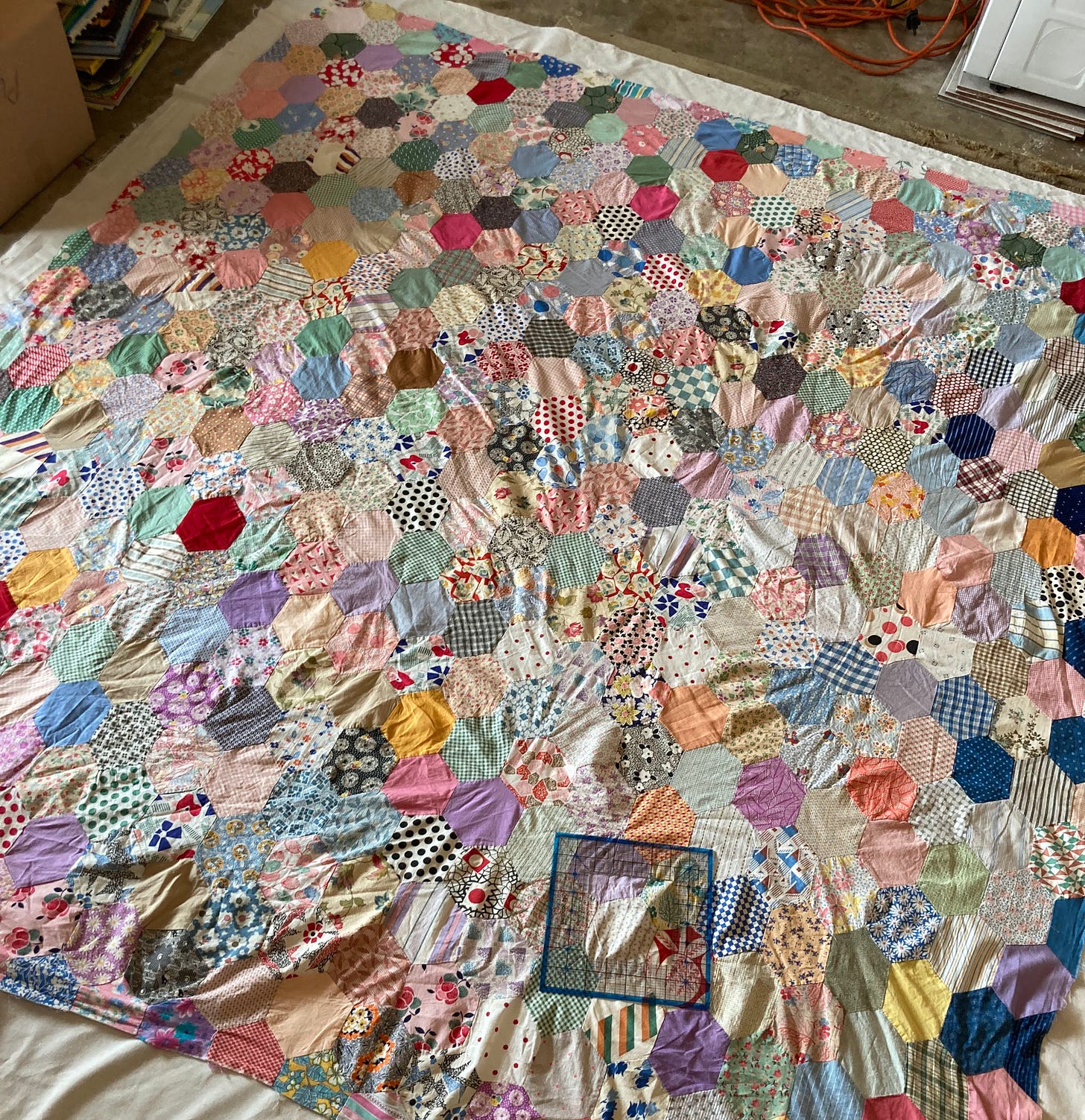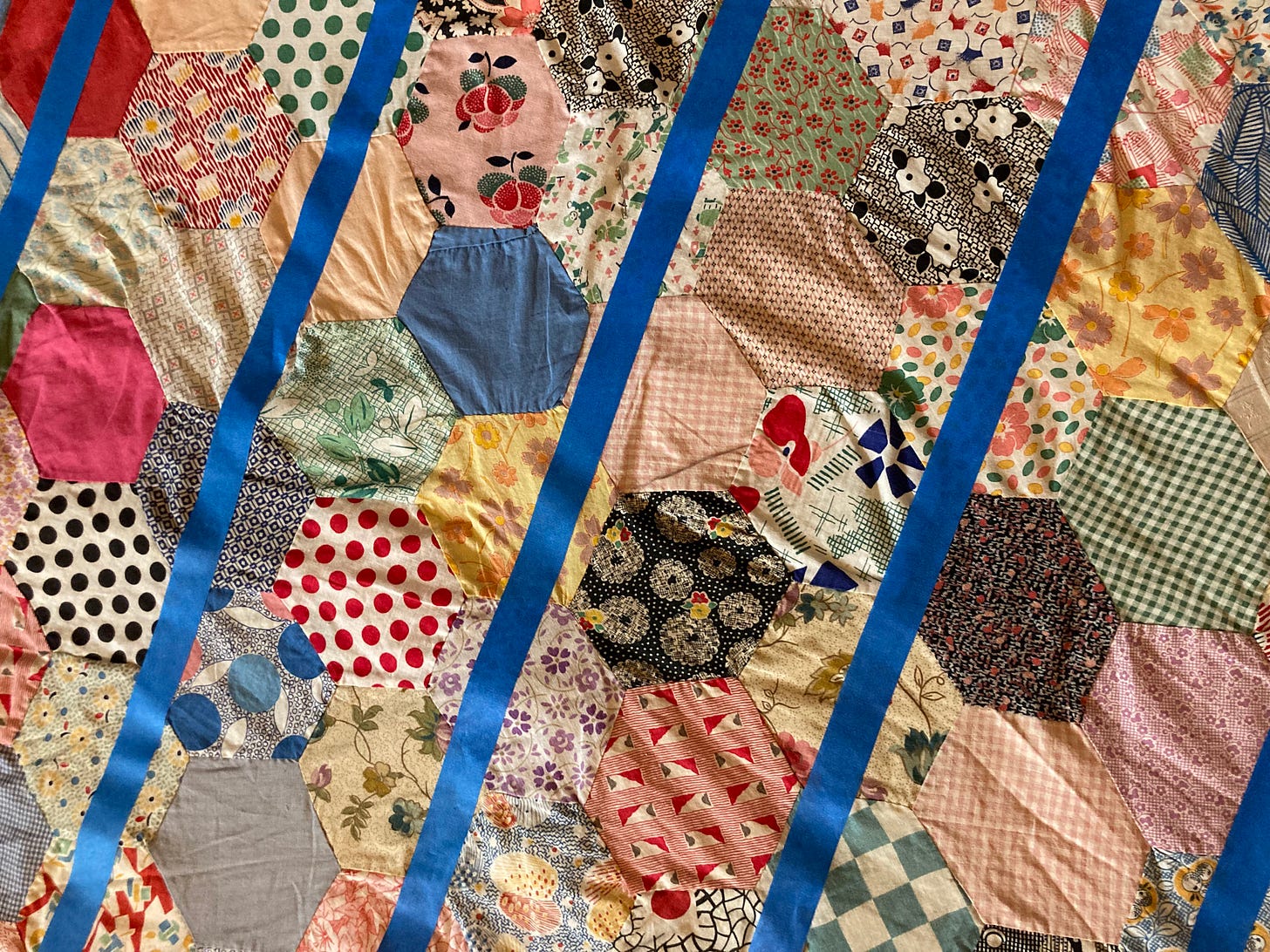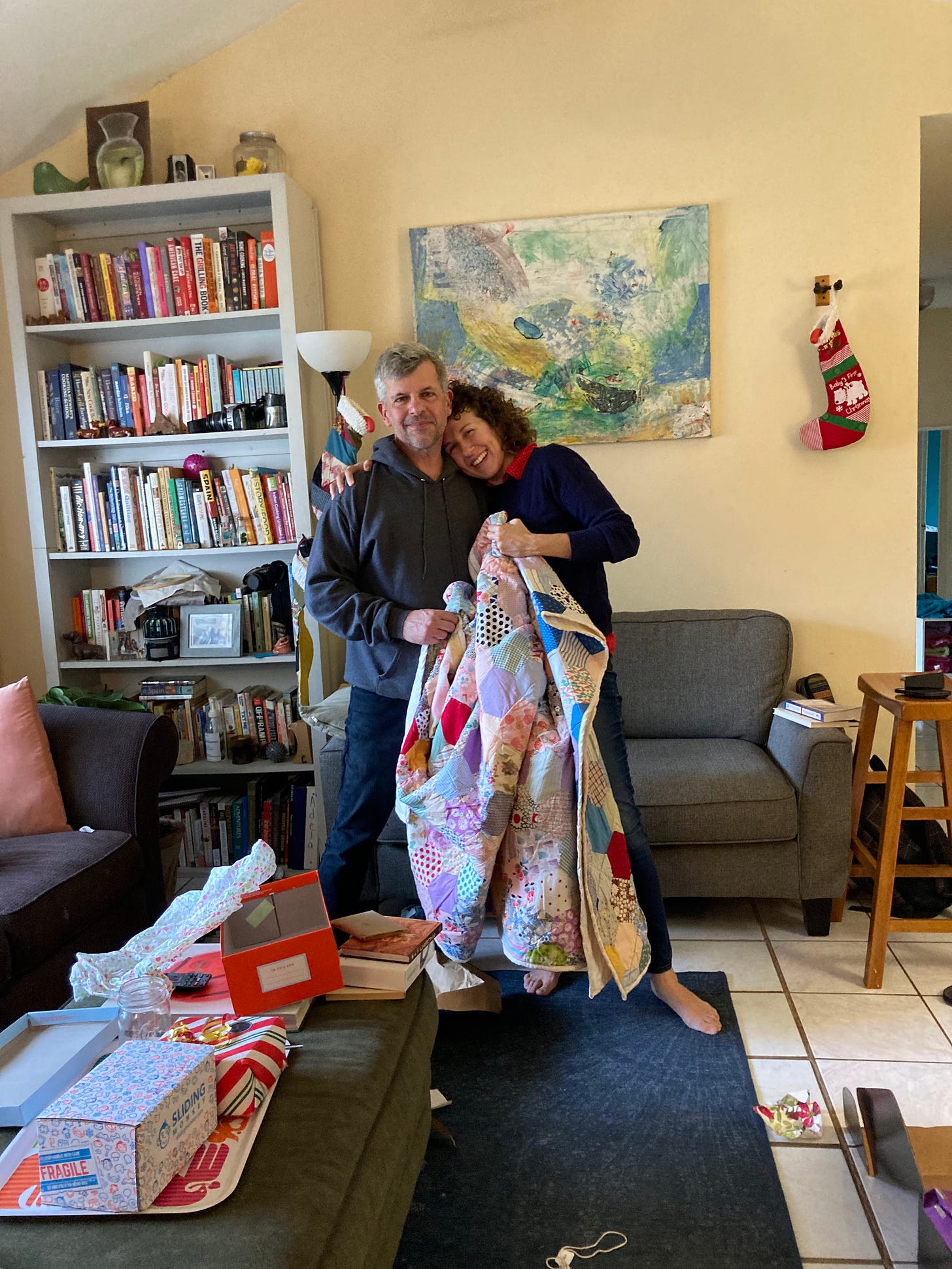The feedsack quilt my great-grandmother never finished (but I did)
What to do with a family heirloom that had been sitting in a trunk for 60 years?
The unfinished hexagon charm quilt top sat in the family trunk for years, decades.
This 85-inch-by-76-inch masterpiece wasn’t exactly forgotten, but in just two generations, we’d collectively forgotten who made it. Was it Karolina, the Swedish ancestor who immigrated to the U.S. in 1893 and died in 1932, or was it her daughter and my maternal great-grandmother Esther, a seamstress who died on Easter in 1959?
I don’t remember when my late grandmother first showed me this artifact, but I remember its smell. Musty and acrid, like rotten mothballs.
The stitches were sturdy, but I wasn’t sure it would survive the washing machine. But what I saw wasn’t a family object that belonged in a trunk. I saw a UFO — quilter’s parlance for unfinished object — that belonged on a bed.
I started quilting when my youngest son was born, in 2010, the same year I started The Feminist Kitchen. I’ve long loved sewing, a hobby that both my mother and grandmother hated, which is why this quilt top from our foremothers sat unfinished for so long.
Quilting has brought me much solace during the past decade when my extended friend-family circle welcomed and said farewell to many members. Baby quilts have become a favorite way to shower my friends’ offspring with love.
I’ve made two full-sized quilts, but this one was different. I didn’t cut up a single scrap and decide where it belonged. I wasn’t the one fretting over whether the pieces were straight. Someone else’s hands mastered those 120-degree corners. But this quilt became mine to finish.
The quilt top simply needed batting, a back, and binding, but with a quilt this size, that’s a sizable undertaking.
After I started to work with the fabric — washing and ironing the piece, laying it out to cut the rest of the parts to size — I started doing some research about its history.
It turns out that charm quilts, or beggar’s quilts, were a popular style of quilts at the turn of the century and then again during the Depression when quilters collected as many different fabrics as possible. True charm quilts don’t repeat any fabrics.
This one has a few duplicates, but not many. Its maker paid attention to piece placement, too. A small garden of solids on one end, a collection of well-spaced polka dot pieces in another. Each 5-sided, 5-inch piece of fabric pieced carefully with another 5-sided, 5-inch scrap, the hems perfectly even.
Eleven stitches per inch, all by hand.
A king-size quilt by modern measure, made by a queen.
The only problem was, I wasn’t sure which one.
The process of finishing a quilt is relatively simple. Make a three-layer sandwich with the quilt top on top of the batting (the fluffy stuff in the middle) and a back fabric, and then pin those layers together before stitching them together, by hand or by machine.
Once you’ve quilted the layers, which can take days on a quilt of this size, the only step left is called binding, where you seal the edge of the quilt with a folded-over strip of fabric.
When I’m making a quilt from scratch, these last steps are the ones that I don’t look forward to. Feeding this heavy mass of fabric through a machine is hard on your back. I have to stretch before I begin and take breaks, lest the pinching pain in my shoulders becomes so bad that I have to take a week off before starting again.
It’s a lot of labor without a lot of creativity, but it gave me so much time to think about Esther and Karolina.
Before I started sewing, I took a moment to lay on the quilt top and soak up their essence. Their pains and losses, their joys, their successes, their quiet moments of reprieve, their aching for home and loved ones.
I’m the heir that looms on stuff like this.
Did Karolina finish this before she died? Was this Esther’s handiwork? Did she start this project before or after her husband walked out on her and her teenage kids? Was my great-grandmother’s rejection of her mother’s trade (sewing) an expression of her proto-feminism? Where on earth did they get all these fabrics?
Over the weeks I worked on this quilt, I found out that some of these questions are easier to answer than others.
To be continued in part 2: The historic roots of feedsack fashion in Southwest Missouri
I’m so glad to finally share the story of this quilt with Feminist Kitchen readers! Finishing this project has been on my sewing bucket list for years, and I’m so glad I carved out the time in December to work on it.
I’m signing off this post with a photo of Frank and me on the day I shared the finished project with him. I wrapped up the quilt as a Christmas gift to him, but it was really a present for us. A quilt we can sleep under for many years to come. An offering from my family tree to his. An invitation to share this part of myself that stands in awe of what came before as we create something new, one stitch at a time.
Look for the second part of this post on Friday. Thanks for your Substack support!
Addie
P.S. If you love this type of ancestor work, reach out! I have been having the most wonderful conversations with folks about their well and chosen ancestors as part of Don’t Fear the Death Card, my tarot business that is so much more than tarot. I don’t read fortunes with the cards; I use them to ask questions to help people reveal deeper truths about their past and present.
For example, this quilt is what I’d call my 10 of Pentacles work, a representation of my being a bridge between my ancestors and the generations to come, a coming together of different pieces that build a legacy far bigger than me. I think we all have 10 of Pentacles work to do, throughout our lives. What’s yours?








You write your stories so beautifully then add pictures that reveal another aspect of the beautiful life you’re creating each day. What a role model you can be and though it looks easy-when you do it, I appreciate the effort you put into every word and stitch!
Thanks for sharing the process of this masterpiece! The work and toil over completing this quilt represents the journey to where we are now.